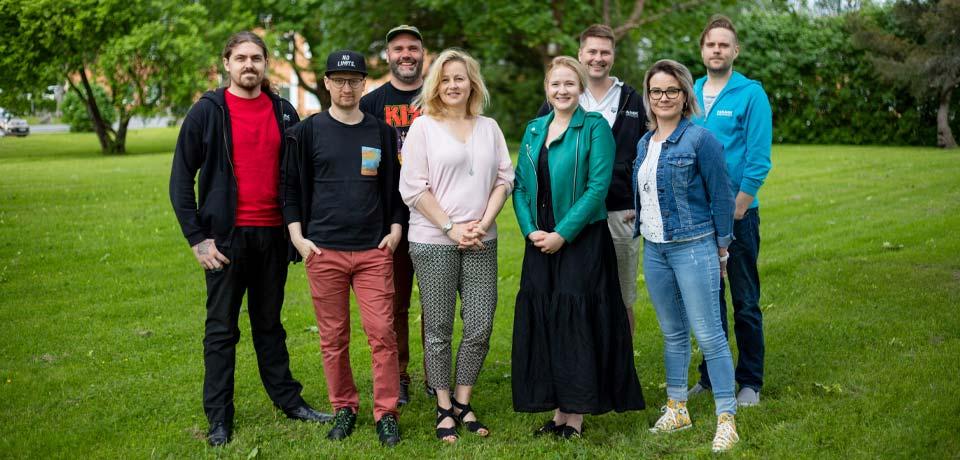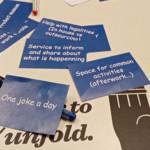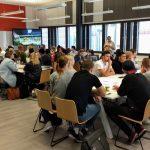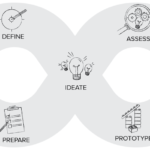
Kristiina Kiiski, Jukka Raitanen & Jari Jussila
This article elaborates on how HAMK Design Factory approaches its organizational culture, what are the different stakeholders inside the higher education institution that affect the manifestation and outcomes of the culture, and how the external networks influence the co-creation of the identity of HAMK Design Factory.
Organizational culture
Organizational culture defines the basic assumptions that are invented, developed, or discovered by a group to learn how to cope with the problems it faces regarding external adaptation and internal integration. The mechanisms are deemed to be valid and taught onwards as the operational and behavioral model of the organization turns into a culture. Organizational culture can be measured through visible artifacts, values, and basic assumptions that form an overall picture of the culture. (Schein, 1984)
Culture is imbued in the way the employees feel about an organization. A feeling of membership brings alive the ownership of one’s work and the authority and responsibility regarding the continuous development of the work. Creating an empowering culture derives from the decision of the employer to embed an employee-first mentality and cherish the company-employee relationship (Shook, 2010). From the perspective of HAMK Design Factory, there is also a need to develop organizational change that would support the student-centered culture and add value to the interactions between different stakeholders of the community.
Cultural change
Shook’s (2010) model of cultural change highlights how changing peoples’ behavior is a powerful way to alter organizational culture. This change can be boosted by defining the behavioral models that need to be changed, providing training to support the change, and reinforcing the wanted behaviors. Changes in behavior translate to changes firstly in the values and attitudes inside the organization and through those they affect the culture. In higher education at HAMK, the change agents can be seen coming from various groups (Kunnari et al., 2021):
- Teachers – Creating new learning platforms that support the changing environment and supporting the cultural change
- Students – Primary users of the new culture. Catalysts of the changing environment by reacting either positively or negatively
- HAMK Staff – Supporting the change by creating the platform of change
- Design Factory Staff – Enabling the change by actions and driving the student-centered organizational culture of Design Factories
- Sponsor organizations – Different organizations give perspective on how the organizational culture could be changed to provide benefits for the cooperation
From a management point of view, when creating nimble working cultures, the employees must have the power to change their working environment and also be given the tools to assess the problems that lie in the proximity. How do we enable an environment that is profoundly something that supports the desired behavior, helps the employee to identify when mistakes are made and where there are problems and ease the communication between different layers inside the organization?
Lean cultural shift accepts the fact that in working environments there will be various problems, but reactive and learning cultures should recognize and solve the problems, and learn from the mistakes made (Shook, 2010). Schein (1984) also notes cultural elements as learned operational models to meet the problems. Organizational learning can be gained through two different learning mechanisms. In positive problem-solving, the selected solution generates typically positive reinforcement regarding its outcome. In the anxiety-avoidance mechanism, the behavior is targeted towards avoiding anxiety and stressful situations, which is typical when the organizational culture reaches the mid-life point (Schein, 1984). The two different mechanisms operate in parallel but have different characteristics, anxiety-avoidance being the more stable one.
One of the driving forces in the HAMK Design Factory is the learnings from design thinking (Jussila et al., 2022), where the results are unknown in the beginning and there is a vast number of directions that can be searched. The culture is thus created by the decisions and activities done, empowering the people who are forming the new culture. In the selected approach the problems are seen as possible situations to learn new ways of coping.
Five stages of organizational culture
Laloux (2014) has described five stages of organizational culture, which he designated a colour (Red, Amber, Orange, Green) depending on how “evolved” they are. According to him, Red organizations are structured around a strong leader, who has absolute power over others, which can still be found today in the form of street gangs and mafia. Amber organizations manifest a static pyramidal structure with stacked layers of hierarchy and a clear chain of command. In Amber organizations, people identify with their job descriptions and their place in the organizational hierarchy. The dominant leadership style is “command and control”, where decisions are made at the upper level of the hierarchy and the lower levels simply follow orders and rules from above.
Orange organizations manifest more degrees of freedom than Red and Amber organizations in order to increase innovation and beat the competition. Multidisciplinary and cross-functional initiatives are set up to drill holes into the rigid functional and hierarchical boundaries of the pyramid to speed up communication and foster innovation. Managers and employees in Orange organizations are given targets and milestones to achieve and some autonomy in terms of how to achieve them. In Green organizations, freedom is further increased, by dispersing decision-making authority to the front lines, which makes them more agile and less hierarchical than their counterparts. Green organizations seek to empower and support the emergence of bottom-up processes and gather input to development from all.
Conclusions
Reflecting on the five stages of organizational cultures described by Laloux (2014), a certain tension can be recognized in HAMK Design Factory culture and the overall organizational culture. Design Factories in the Design Factory Global Network (DFGN), which HAMK is part of, share the values of Green organizations. They aim to empower students and employees and give decision-making authority to the front lines. Bottom-up processes are encouraged, and everyone is invited to give feedback and contribute to the development of new practices. Quite obviously, this leads to conflicts when Green organization’s low hierarchy and agile decision-making face “command and control” leadership and rigid functional and hierarchical boundaries in multidisciplinary and cross-functional Design Factory projects and implementations.
HAMK Design Factory supports the organizational culture transformation towards Green organization, of being the same family, both inside HAMK and internationally within DFGN and Regional University Network. This transformation is part of the ongoing activities in Design Factory projects implemented in different HAMK campuses, as well as Future Advanced Skills Academies’ (FASA) work.
Authors
Kristiina Kiiski works in HAMK Design Factory as a communication and marketing planner. Her main tasks include marketing communications and content marketing for the courses, events, and social media. Kiiski also works as a project coordinator for HAMK Design Factory research projects.
Jukka Raitanen operates as a community manager in HAMK Design Factory and as a lecturer in HAMK School of Entrepreneurship and Business. He organizes multidisciplinary and international student projects for the needs of the industry at HAMK and RUN-EU -Regional University Network.
Jari Jussila is Director of HAMK Design Factory and Principal Research Scientist at HAMK Smart Research Unit. Jari Jussila has been co-creating interdisciplinary learning opportunities in Design Factory and the School of Entrepreneurship and Business in HAMK.
References
Jussila, J., Raitanen, J., & Tuomela, V. (2022). Design thinking in HAMK Design Factory. HAMK Unlimited Professional, 17.6.2022.
Laloux, F., & Wilber, K. (2014). Reinventing organizations: A guide to creating organizations inspired by the next stage of human consciousness. (1st ed.). Brussels: Nelson Parker.
Kunnari, I., Tuomela, V., & Jussila, J. (2021). Teacher-facilitators’ job-crafting: making meaning and relevance in authentic learning environments. International Journal of Management, Knowledge and Learning, 10.
Björklund, T., Clavert, M., Kirjavainen, S., Laakso, M., & Luukkonen, S. (2011). Aalto University Design Factory in the eyes of its community. Aalto University Design Factory.
Schein, E. H. (1984). Coming to a New Awareness of Organisational Culture. Sloan Management Review, 25(2), 3–16.
Shook, J. (2010). How to change a culture: Lessons from NUMMI. MIT Sloan Management Review, 51(2), 63–68.





